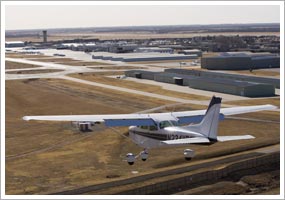| This ePilot Flight Training Edition is sponsored by

Advertisers
                  
Do not reply to this e-mail. Got news? Contact ePilot. Having difficulty using this service? Visit the ePilot Frequently Asked Questions now at AOPA Online or write to [email protected].
Aircraft Owners and Pilots Association
421 Aviation Way
Frederick, MD 21701
Tel: 800/USA-AOPA or
301/695-2000
Copyright © 2007 AOPA. | | Training Tips | | 'I'LL CALL YOUR BASE'
 A highly instructional set of in-flight circumstances recently came up in the AOPA Aviation Forums, thanks to a pilot who related an experience he had while practicing takeoffs and landings at a towered airport. After reporting that he was about to turn base, he was instructed to extend his downwind. The controller said, "I'll call your base." The reason was a twin-engine Cessna preparing for takeoff. A highly instructional set of in-flight circumstances recently came up in the AOPA Aviation Forums, thanks to a pilot who related an experience he had while practicing takeoffs and landings at a towered airport. After reporting that he was about to turn base, he was instructed to extend his downwind. The controller said, "I'll call your base." The reason was a twin-engine Cessna preparing for takeoff. When the controller eventually radioed clearance to land, the pilot saw that the twin still had not departed. "He says my call sign and 'cleared to land.' This is right after the twin read back his takeoff clearance. The twin had still not come onto the runway, so I figured I was still waiting for him to call my base," he wrote. The controller saw that the aircraft had not turned base and called back to restate and clarify the landing clearance. The point that the landing pilot did not recognize was that, although the controller never actually called his base, the landing clearance sufficed to do so. "Cleared to land" is defined this way in the Pilot/Controller Glossary : "ATC authorization for an aircraft to land. It is predicated on known traffic and known physical airport conditions." The twin Cessna on the ground certainly qualifies as "known traffic." The pilot can be commended for erring on the side of caution; however, an instructor might have suggested that the pilot query ATC as soon as doubts arose. This is true when resolving an airborne conflict, too. In that case AOPA's Handbook For Pilots offers this guidance: "Should you decide that maneuvering turns are required to maintain proper spacing, advise the controller if possible. Except for an emergency situation, never execute a 360-degree turn in the traffic pattern without first advising the controller." Communication and cooperation make it all work. Don't hesitate to speak up when in doubt. Safety suffers if a misunderstanding is allowed to blossom into something worse, as the January 1999 AOPA Pilot column "Pilot Counsel: Defying ATC Instruction" demonstrates. Many pilots will hear the words "I'll call your base" someday. Thanks to a pilot who shared a learning experience, they'll be better prepared for what follows.
| | Your Partner in Training | | By now you may have accumulated enough hours and experience to take your private pilot checkride. Or perhaps you are just beginning your training, but you already have those "checkride jitters." The Private Pilot Practical Test Standards tell you everything you need to know to prepare. See AOPA Online to learn more. If you have any questions after visiting our site, call 800/USA-AOPA weekdays between 8:30 a.m. and 6 p.m. Eastern. As an AOPA Flight Training Member, you have access to all of the features within AOPA Online and AOPA Flight Training Online. Login information is available online.
| | Flight Training News | | FAA OFFERS ONLINE IACRA TRAINING
It's time to get your paperwork in order for your checkride, and that includes filling in all the blanks on FAA Form 8710-1. The FAA is moving to an online system for processing airman applications. Are you up to speed on the Integrated Airman Certificate and/or Rating Application, more commonly known as IACRA? If not, don't fret. A free interactive training course is now available. Visit the FAA's Web site, where you can act out any role, from student to FAA inspector. ERAU ESTABLISHES McNAIR SCHOLARS PROGRAM
Thanks to a grant from the U.S. Department of Education, Embry-Riddle Aeronautical University has established a program to assist students from low-income families, first-generation college students, or students from a federally defined minority group. The $879,596 grant is funding a four-year McNair Scholars program at Embry-Riddle's Daytona Beach, Fla., campus. The program prepares qualified undergraduate students for doctoral study, with the goal of increasing the number of students from under-represented groups obtaining doctoral degrees. McNair scholars receive a scholarship, help in seeking financial aid, tutoring, and academic and career counseling. They also receive mentoring from a faculty member with a doctoral degree. For more information, contact Maranda McBride by telephone at 386/226-7926 or by e-mail. CAREERS IN EDUCATION RECEIVES $125,000 DONATION
Careers in Aviation Inc., a nonprofit organization that helps students explore opportunities in aviation, received a $125,000 donation from Flight Training Services International (FTSI). The money is an endowment that will provide annual scholarships for students to complete their education. The first FTSI scholarship will be awarded in fall 2008 and will be earmarked for a student at Embry-Riddle Aeronautical University.
| | Inside AOPA | | CATCH-A-CARDINAL GETS THE SILKSCREEN TREATMENT
Perhaps you haven't had much time to ponder the placards on your trainer or gaze into the instruments on the panel and wonder how they were built. You can get a glimpse in this week's Catch-A-Cardinal update as we visit Air Capitol Dial Inc. in Wichita, Kan., and see the Cardinal panel undergo silk-screening. You'll also see the special paint and labeling applied to the intricate parts of instruments such as the attitude indicator and tachometer. QUIZ YOURSELF ON PREVENTIVE MAINTENANCE, INSPECTIONS
When you think of preventive maintenance for an airplane, do you tend to shrug? Perhaps that's because you're renting an airplane and maintenance is not your responsibility—not at this point in your training. But that will change if you decide to purchase an airplane. As an owner, there are certain kinds of preventive maintenance tasks that you can perform yourself, saving time and money. It's important to know which ones qualify under the federal aviation regulations and which ones don't. This week's AOPA Air Safety Foundation Safety Quiz will teach you about required inspections, maintenance-related regulations, logbook entries, and more. Plus, you can earn a chance to win a Sporty's Air-Scan V aviation radio/scanner. Take the quiz. HAVE YOU UPDATED YOUR AOPA MEMBER PROFILE?
To make the most of your membership and allow us to serve you better, please visit AOPA Online and update your personal member profile.
| | Training Products | | 'THE ART AND SCIENCE OF BETTER LANDINGS'
Landings, landings, landings. We talk about them, analyze them, and constantly strive to make them better. Gold Seal Flight, publisher of the Gold Seal Online Ground School, has released a new book that aims to improve your landing techniques by breaking the process into a series of steps. What's unusual about The Art and Science of Better Landings is the presentation: It's a two-part system consisting of a 63-page e-book in .pdf format coupled with an online component. The idea is that you read a chapter in the e-book, then watch a multimedia presentation on the Internet to broaden your understanding. The Art and Science of Better Landings is available for download and sells for $16.95. Note: Products listed have not been evaluated by ePilot editors unless otherwise noted. AOPA assumes no responsibility for products or services listed or for claims or actions by manufacturers or vendors.
| | Final Exam | | Question: In a discussion with my flight instructor about chart revisions, we questioned the FAA's procedure for making the revisions known between chart cycles. Do you have any information on how that is done? Answer: While major changes, such as airspace redesigns, are scheduled to coincide with the charting cycle, the FAA's National Aeronautical Charting Office receives input for changes to its aeronautical and base information every day. The significant changes are put in the Aeronautical Chart Bulletin at the back of the Airport Facility/Directory (A/FD) until the chart itself is updated. Flip through that portion of an A/FD, and you'll see a lot of added obstructions, identified by latitude and longitude. You'll also see potentially important frequency changes, additions or deletions of airports, and navaid changes. There may be changes to military operations areas, military training routes, warning areas, or other special-use airspace. Read more on this topic in the August 2005 AOPA Flight Training . Got a question for our technical services staff? E-mail to [email protected] or call the Pilot Information Center, 800/872-2672. Don't forget the online archive of "Final Exam" questions and answers, searchable by keyword or topic.
| | Picture Perfect | Looking for some really fabulous aviation photography? All the air-to-air photos and beautifully detailed ground images used by AOPA Pilot magazine over the years are yours at the click of a mouse button. Download your favorite images to use for wallpaper, send an e-postcard, or order prints online. For more details, see AOPA Online.
| | Weekend Weather | See the current weather on AOPA Online, provided by Jeppesen.
| | ePilot Calendar | UPCOMING FLYING DESTINATIONS:
Somerset, TX. A Mediterranean Assault World War II Reenactment takes place Dec. 7 and 8 at Cannon Field (53TX). Contact Ryan Short, 210/646-9628, or visit the Web site. To submit an event to the calendar or to search all events visit AOPA Online. For airport details, including FBO fuel prices, see AOPA's Airport Directory Online. FLIGHT INSTRUCTOR REFRESHER CLINICS
The next AOPA Air Safety Foundation Flight Instructor Refresher Clinics are scheduled in Orlando, Fla., and Austin, Texas, Dec. 8 and 9. For a complete schedule, see AOPA Online. Can't make it in person? Sign up for the CFI Refresher Online.
| |






















 A highly instructional set of in-flight circumstances recently came up in the
A highly instructional set of in-flight circumstances recently came up in the 

